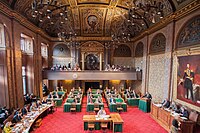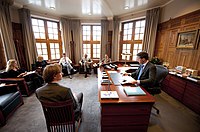Wikipedia
This text was copied from Wikipedia on 22 January 2025 at 4:10AM.
52°04′47″N 4°18′47″E / 52.079631°N 4.313035°E / 52.079631; 4.313035

The Binnenhof (Dutch pronunciation: [ˈbɪnə(n)ˌɦɔf] ⓘ; English: Inner Court) and Buitenhof (Outer Court) is a complex of buildings in the city centre of The Hague, Netherlands, next to the Hofvijver (Court Pond). It houses the meeting place of both houses of the States General of the Netherlands, as well as the Ministry of General Affairs and the office of the Prime Minister of the Netherlands. Built primarily in the 13th century, the Gothic castle originally functioned as residence of the counts of Holland and became the political centre of the Dutch Republic in 1584. It is counted among the Top 100 Dutch heritage sites. The Binnenhof is among the oldest parliament buildings in the world still in use.
History


Little is known about the origin of the Binnenhof. Presumably, the grounds next to the Hofvijver lake, and the small homestead on it, were purchased by Count Floris IV of Holland from Meiland van Wassenaar in November 1229. Between 1230 and 1234 he had the homestead expanded to a small keep. After Floris' son and successor William II was crowned King of the Romans in 1248, this construction continued. Between 1248 and 1280, William had the Ridderzaal built. To its left and right, walls were built, which divided the area in front of the building from that behind it. Both walls had a gate. At the end of the wall on the left, near the Hofvijver, the court chapel was built, and near that the Ridderhuis ('Knights' House') where visiting knights were sheltered. William died in battle in 1256, before the construction of the Ridderzaal had finished, and the castle was completed during the reign of his son, Floris V.
The Binnenhof was the residence of the counts of Holland for a short period. After the house of Holland died out in 1299, the county fell into the hands of the counts of Hainaut. The counts of Hainaut barely resided in the Binnenhof in the early 14th century. Duke Albert I of Bavaria and his successor William II lived in the Binnenhof virtually permanently. Under their reign, the castle saw a sizeable expansion, and gradually became enclosed by buildings.[1][2]

When Holland had become part of the Burgundian Empire in 1432, the Binnenhof lost its purpose and was abandoned. Part of the complex was later made into the residence of the stadtholder of Holland, who governed the county in absence of its ruler. After Philip II was deposed as Count of Holland and the Dutch Republic was proclaimed in 1581, the Ridderzaal was initially a public space, often used by traders, stallholders and book sellers. In 1584, stadtholder Maurice moved into the stadtholder's quarter, and in the same year, the Ridderzaal became the meeting place of the newly formed States General of the Dutch Republic. The expansions of the Binnenhof by Maurice were the beginning of a gradually advancing reconstruction of the castle that ended after the construction of the southern wing under stadtholder William V, in the late 18th century.[1][3]

Between 1806 and 1810, under French rule, the administrative centre of the Netherlands was moved to Amsterdam, and the Binnenhof became useless and it was considered for demolition. When the Netherlands gained independence from France, however, the government moved back to the Binnenhof. The existence of the building was in danger a second time in 1848, when a new constitution instituted a system of parliamentary democracy and the States General wished to symbolically demolish the old government buildings and build a new complex. The local residents, however, cared more for the historic value of the building, and successfully protested against demolition.[4]
Layout
Originally built as a ballroom, the Gothic Ridderzaal (a great hall, literally 'Knight's Hall') today forms the centre of the Binnenhof. Every third Tuesday of September, on Prinsjesdag, this is where the King holds his annual Speech from the Throne. Other buildings shape a rectangle around the Ridderzaal, creating a large courtyard in front of the building, and a smaller square behind it. A gilt Neo-Gothic fountain adorns the courtyard and a statue of King William II, one of few Dutch equestrian statues, guards its gate, the Stadtholder's Gate, which dates from 1620.
Looking out over the Hofvijver, the Senate sits in a chamber in the western corner of the Binnenhof, while the House of Representatives originally sat in the southern corner, at the other side of the Stadtholder's Gate. Today, the lower house meets in a chamber in the large modern eastern part of the complex. The Prime Minister's office has since 1982 been located in the small tower in the northern corner, simply called the Torentje ('Little Tower').[5] Located in the north-western wing, the Trêveszaal is a meeting room originally built for negotiations during the Eighty Years' War; today, it is the meeting room of the Cabinet.
-
The Ridderzaal in 2019
-
The Trêveszaal Historic meeting room
-
The Handelingenkamer, the Library of the Binnenhof
-
The Senate (Netherlands) Plenary Hall of the Senate
-
The office of the Prime Minister of the Netherlands
-
Throne of the monarch of the Netherlands in the Ridderzaal
Renovation
From fall 2021 (after Prinsjesdag), the Binnenhof has been undergoing a full renovation.[6]
In 2014, a specially assigned task force, Renovatie Binnenhof, suggested a large renovation for the Binnenhof. Before that, only small maintenance had been done to the complex. Mostly the older buildings, next to the Hofvijver, are in need of renovation, such as Het Torentje (office of the Prime Minister of the Netherlands), de Trêveszaal (where the cabinet of the Netherlands holds its weekly meetings) and several other buildings. The renovation will mostly focus around air conditioning and central heating installations, IT systems, elevators, fire safety and modernisation of the kitchens.[7]
In December 2015 a majority of the Dutch Parliament elected a plan for a full renovation of the complex, which will take approximately 5.5 years and is estimated to cost around €475 million. The first plan was to start the renovations in 2018, however this was postponed several times. The Senate will be moved during the renovation to the former building of the Ministry of Foreign Affairs, which has been prepared by a €40 million remodeling. The Prime Minister of the Netherlands and the Ministry of General Affairs will be moved to the Catshuis, where a temporary office building will house several hundred officials. The senate will be moved to Huis Huguetan, the former Supreme Court of the Netherlands building.[6] The house of representatives will be moved to the former building of the secretary of state.
In 2017, the architectural firm Office for Metropolitan Architecture (OMA) received the assignment for designing and preparing the renovation. In early 2019 information was leaked that the projected cost for several 'activities' such as painting, carpets and security was off by around €60 million. Also, in 2019, the contract with OMA was discontinued. Another architectural firm, DOK, under the lead of architect Pi de Bruijn, who also designed the new construction for the Senate, was assigned to finish the plans. In the summer of 2021, politicians and officials will be moved to their temporary workplaces and after Prinsjesdag, which is on 21 September 2021, construction will begin in and around the Binnenhof.[8]
The estimated costs of the renovation had risen to €2 billion by 2024, and completion was expected by 2028 at the earliest. Discoveries of additional deferred maintenance, defects, and asbestos were cited amongst the causes. For example, it was found that the ceiling in the Senate was unstable, and water of the Hofvijver lake was entering the complex through holes in the foundation.[9]
References
- ^ a b "Binnenhof". De Pagina's over Den Haag (in Dutch). Archived from the original on 20 October 2014. Retrieved 14 July 2014.
- ^ "Binnenhof: het grafelijk kasteel". Geschiedenis van Den Haag (in Dutch). Retrieved 14 July 2014.
- ^ "Geschiedenis van de Ridderzaal". IS Geschiedenis (in Dutch). Archived from the original on 3 July 2014. Retrieved 14 July 2014.
- ^ "'Binnenhof twee maal bijna afgebroken'". NU.nl (in Dutch). 31 May 2010. Retrieved 12 August 2013.
- ^ "Premier Rutte in het Haagse torentje". NOS (in Dutch). 14 October 2010. Archived from the original on 11 January 2014. Retrieved 12 August 2013.
- ^ a b "Tijdlijn renovatie Binnenhof - Vastgoed - Rijksvastgoedbedrijf". 13 February 2017. Archived from the original on 17 May 2022. Retrieved 19 May 2021.
- ^ "Kabinet blijft bij keuze om Binnenhof in een keer helemaal te verbouwen: 'Gefaseerd renoveren kost meer tijd en geld'". Algemeen Dagblad (in Dutch). 2021-01-06. Retrieved 2023-11-18.
- ^ "Twee coördinerend architecten voor renovatie Binnenhof - Nieuwsbericht - Rijksvastgoedbedrijf". 23 March 2017.
- ^ Du Pré, Raoul; Meijer, Remco (16 April 2024). "Kosten renovatie Binnenhof nog zeker twee keer over de kop; de ene onvoorziene tegenvaller stapelt zich op de andere" [Costs of Binnenhof again doubled; one unexpected setback after the other]. de Volkskrant (in Dutch). Retrieved 16 April 2024.

![The Trêveszaal [nl] Historic meeting room](http://upload.wikimedia.org/wikipedia/commons/thumb/4/48/Tr%C3%AAveszaal.jpg/200px-Tr%C3%AAveszaal.jpg)
![The Handelingenkamer [nl], the Library of the Binnenhof](http://upload.wikimedia.org/wikipedia/commons/thumb/5/5f/Handelingenkamer_2023_02.jpg/184px-Handelingenkamer_2023_02.jpg)




2 Annotations
Second Reading
Terry Foreman • Link
Binnenhof (The Hague)
https://en.wikipedia.org/wiki/Bin…
Third Reading
San Diego Sarah • Link
The Court at The Hague:
"As soon as they were assembled, they went forth, two and two, in the same order as we have named them, going directly to the King's lodging, which is separated from the Palace but by a Ditch, whose two sides are joined by a stone bridge.
"That Palace is named the Court, or the Court of Holland, because it served sometime for dwelling to the Counts; as it comprehends now in its enclosure the apartments, where the Estates General assembly; the Council of Estate of the United Provinces; the Estates of Holland; the Council of Estate of the same Province; the Reckoning-chambers of the Generality, and of the Province of Holland: The two Courts of Justice, and the apartments assigned for the lodging of the Princess Royal, and of the Prince of Orange."
From A RELATION IN FORM of JOURNAL, OF THE VOYAGE And RESIDENCE Which The most EXCELLENT and most MIGHTY PRINCE CHARLES THE II KING OF GREAT BRITAIN, &c.
Hath made in Holland, from the 25 of May, to the 2 of June, 1660.
Rendered into English out of the Original French, By Sir WILLIAM LOWER, Knight. [Edited by SDS into modern English. Apologies for any errors.] Page 36.
https://quod.lib.umich.edu/e/eebo…